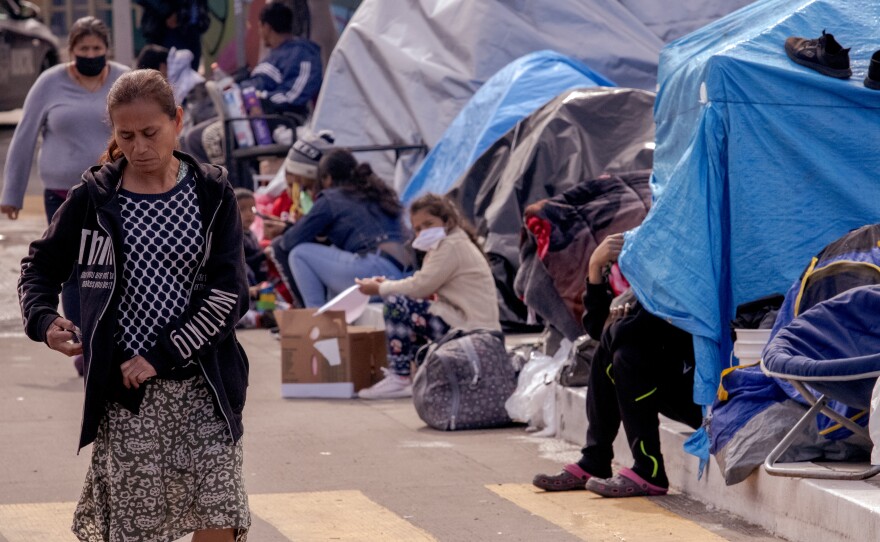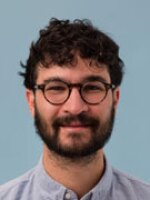Marjorie Rosales has been living in Tijuana for a year, after fleeing Honduras with her daughter. Almost a month ago, she told KPBS she would stay outside the San Ysidro Port of Entry for as long it took for the Biden Administration to allow her to claim asylum in the United States.
Last Friday, she was still there.
“It’s been tough, because of the rain, my clothes are now wet, there’s been freezing temperatures at night and in the morning,” she said. She was wearing shorts, having left a pair of pants in a spot of sunshine to dry.
Rosales is not alone. Hundreds of other asylum-seekers are now camped out at El Chaparral, a plaza on the Mexican side of the port of entry.
They’re some of the thousands of asylum-seekers stuck in Tijuana, who have been prevented from applying for asylum in the United States, because of a Trump-era rule barring their entry.
The Biden administration, for the most part, has kept that rule in place, citing the pandemic.

But some asylum-seekers are being processed. In February, the Department of Homeland Security, in coordination with the United Nations High Commissioner for Refugees (UNHCR) and the Mexican government, began processing asylum-seekers who had been sent back to Mexico under the “Remain in Mexico” program.
RELATED: ‘We’re Not Sleeping Because We’re So Happy’: Family Sent Back To Mexico Finally Reaches US
As of Friday, it had only processed about 1900 of those asylum-seekers, according to UNHCR. Six hundred forty-one had been processed at the San Diego-Tijuana border, leaving thousands of asylum seekers, many who don’t qualify to be processed under the Biden program, without any idea of when they’ll be allowed into the U.S. They are camping out, waiting for information.

“Those that have decided to remain, to stay, are going to remain until they have answers,” said Ian Philabaum, who works for the Innovation Law Lab, which advocates on behalf of asylum-seekers. “They’re going to remain until there is a defined process, where they can identify themselves within that process, and including the steps that they need to take, in order to continue their pursuit of asylum or whatever relief they desire in the United States. The absence of those guidelines is the number one reason this camp exists.”
On Friday morning at the camp, there was a flurry of activity. A kitchen was distributing food, doctors from Tijuana were looking into the health of migrants, and school was in session. The school had been formed by asylum-seekers who had been teachers in their home countries. Children flocked to the donated tables that volunteers had set up and supplied with coloring books. Others followed teachers who led them in games.

“I feel that the children experience stress because of the situation that we are living here, and it’s a way for them to relax,” 26-year-old Evelyn Sanchez, one of the teachers, told KPBS. “In school, we are not necessarily going to learn to write, learn letters or numbers. We are also going to share with our fellow classmates. They share their life experiences.”
She feels that people like her are common in the camp, people with something to provide.
“We’re educated people with principles, with values — and what we want for ourselves is what we want for our children. And, if we are here in Mexico, we aren’t just a nuisance or society’s garbage. We are simply migrants and we have rights, rights the same as everyone else,” she said.
In the first few days of the camp, security was an issue, as provocateurs and traffickers spread misinformation. Now, the camp is watched over by a group of volunteers, including Marco Garcia, also from Honduras.
Garcia stood nearby as asylum-seekers lined up for health checkups from doctors from the municipality of Tijuana.
“When I came, I saw that no one was taking care of us. And so, I took the initiative and got this vest and put it on,” he explained. “When they saw that I was helping them, they said, ‘Hey, brother, I want to help you’ and I said, ‘Excellent!’ So I gave them some vests that people had given to me and, so, we take care of ourselves.”

While many asylum-seekers in the camp are from Central America, especially Honduras, there are people from across the world, including many Haitians, some of whom have recently arrived in Tijuana as the political situation in their country continues to deteriorate.
Jean-Claude Jean spent five years in Chile, after being targeted by organized crime in Haiti.
RELATED: At The San Diego-Tijuana Border, Asylum-Seekers Admitted Back Into The US
“They killed my mother,” he told KPBS. “Because they couldn’t find me and couldn’t find my brother, they went after my mother and hit her with a car. My mother has already died. Because of that, for that reason, I came here….If I arrive in Haiti today, tomorrow I’ll be dead.”

Right now, the Biden administration is focused on finding shelter for the rising numbers of unaccompanied children arriving at the southwest border. The children, who are mostly arriving in Texas, came to the United States after the Biden administration stopped turning back children at the border, a shift in policy from the Trump administration.
The Biden administration has not yet announced when the border will reopen to asylum-seekers, but has stressed that it plans on processing the thousands of asylum-seekers sent back to Mexico under the Remain in Mexico program, before processing those not enrolled in it.

Right now, UNHCR says it’s up to the United States for how quickly those in Remain in Mexico' will be processed. But the refugee agency says it’s interested in continuing to work with and pressing the causes of those who are waiting at El Chaparral. “We look forward to working with the governments of the United States and Mexico as they address the situation of other people with urgent protection needs,” a UNHCR spokesperson wrote to KPBS.

We asked Marjorie Rosales, who wants to be at the port of entry the second a change in policy is announced, if she would ever think about sending her young daughter, Angie, ahead without her. Other families along the border have struggled with the same decision, and sent their children ahead of them.
She shook her head.
“That is why I’m here. To be legal. You understand? I’m asking for help,” she said. “That is, asking that he, Biden, help me, that he help every one of us here. My daughter and I are in danger in Honduras. We’re very afraid of going back.”








